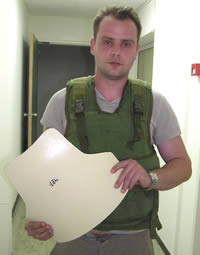A new insert offers Level III ‘plus’ protection at 26 kg/m2 aera density, the insert was selected by the IDF for its new body armor vest, produced by GlassCerax. The company developed a low-cost manufacturing process that enables designers to mold an armor module into an ergonomically shaped form that fits the human body while maintaining effective impact protection and ballistic performance.
Through the process the material is formed into ‘ceramic glass’, which is 20% lighter than comparable tiles fabricated from alumina and cost 25% of comparable plates made of alumina or high density polyethylene. The multi-hit endurance of the molded tile is superior to conventional ceramic tiles, since, its amorphic molecular structure and poreless composition contribute to the reduction of ballistic damage within the impact area, therefore limiting the distribution shockwave and fractures throughout the tile.

The plate is wrapped with polyethylene and adhesives to improve impact protection. The company is currently working on a similar process that will produce plates with Level 4 protection, at the same weight but quarter of the cost of comparable Boron Carbide modules. The complete vest weighs around 7.5 kg, including front, back and side protection and load bearing vest, favorably comparable with the US Army Interceptor Body Armor, which offers half the protected area (since it uses smaller SAPI inserts to protect only the center body vital organs). The enhanced Interceptor, with enhanced front and back E-SAPI, plates and two side armor ESBI inserts weighs much more. Level 4 ‘plus’ ceramic composite inserts are providing further protection against higher threats, including the common armor-piercing AK-47 as well as IEDs.
In this series Defense Update covers the following topics:

















